The canine atopic dermatitis treatment drugs market is estimated to be valued at USD 1,648.5 Mn in 2025 and is expected to reach USD 3,276.3 Mn by 2032, exhibiting a compound annual growth rate (CAGR) of 10.3% from 2025 to 2032.
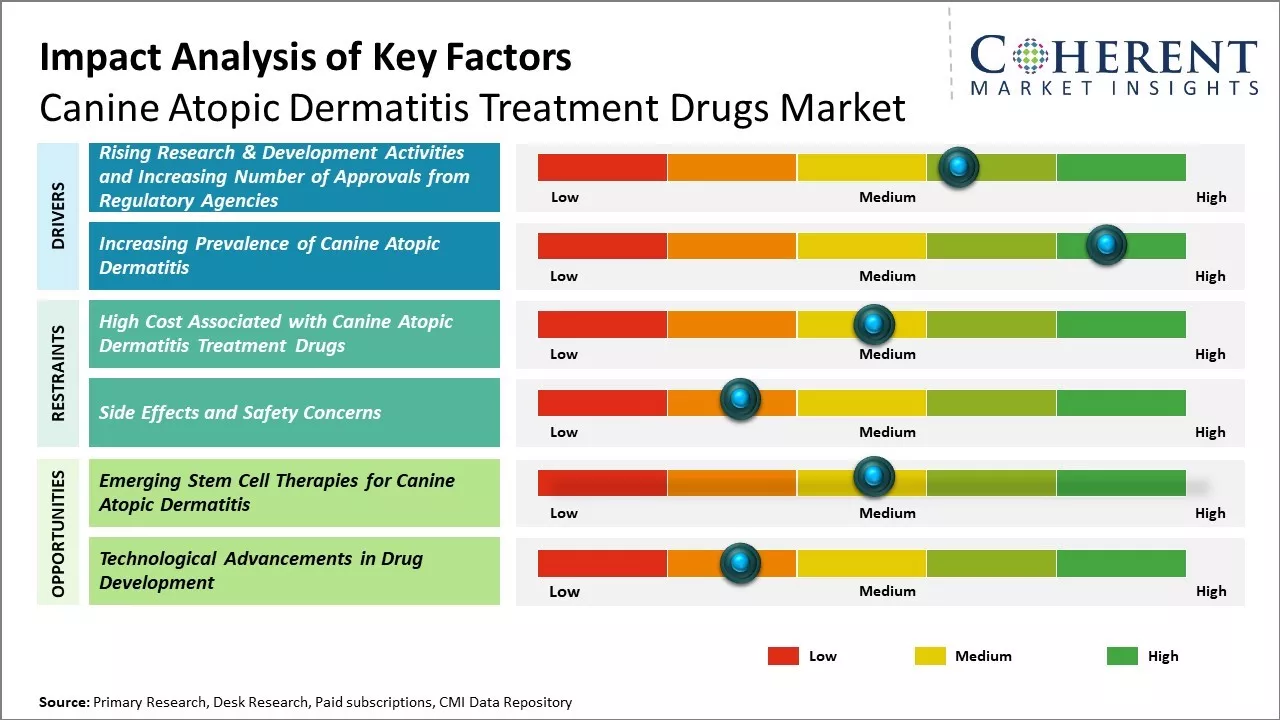
Discover market dynamics shaping the industry: Download Free Sample
The canine atopic dermatitis treatment drugs market is expected to grow steadily over the forecast period. The increasing prevalence of atopic dermatitis in dogs and rising pet care expenditure are contributing to the growth of this market. The market is expected to witness a positive trend over the forecast period. There is a high unmet need for more effective treatments for canine atopic dermatitis. Several pipeline drugs are under development which could become blockbuster products if clinical trials are successful. In addition, growing awareness about atopic dermatitis and its available treatments options among pet owners will continue to support market expansion.
Rising Research & Development Activities and Increasing Number of Approvals from Regulatory Agencies
Pharmaceutical companies are actively investing in research and development to create advanced and highly effective treatment options for canine atopic dermatitis. They are focusing on innovating drug delivery systems, refining formulation techniques, and identifying new therapeutic targets. These efforts have led to the development of enhanced medications, offering improved outcomes for the management of the condition. For instance, in July 2021, Virbac Corporation, a France-based company dedicated to animal health, announced the availability of CYCLAVANCE (cyclosporine oral solution) USP MODIFIED, an oral solution for the control of atopic dermatitis in dogs. While veterinarians in the U.S. are familiar with cyclosporine in capsule form, CYCLAVANCE oral solution represents the first U.S. U.S. Food and Drug Administration approved liquid cyclosporine for dogs in the U.S.
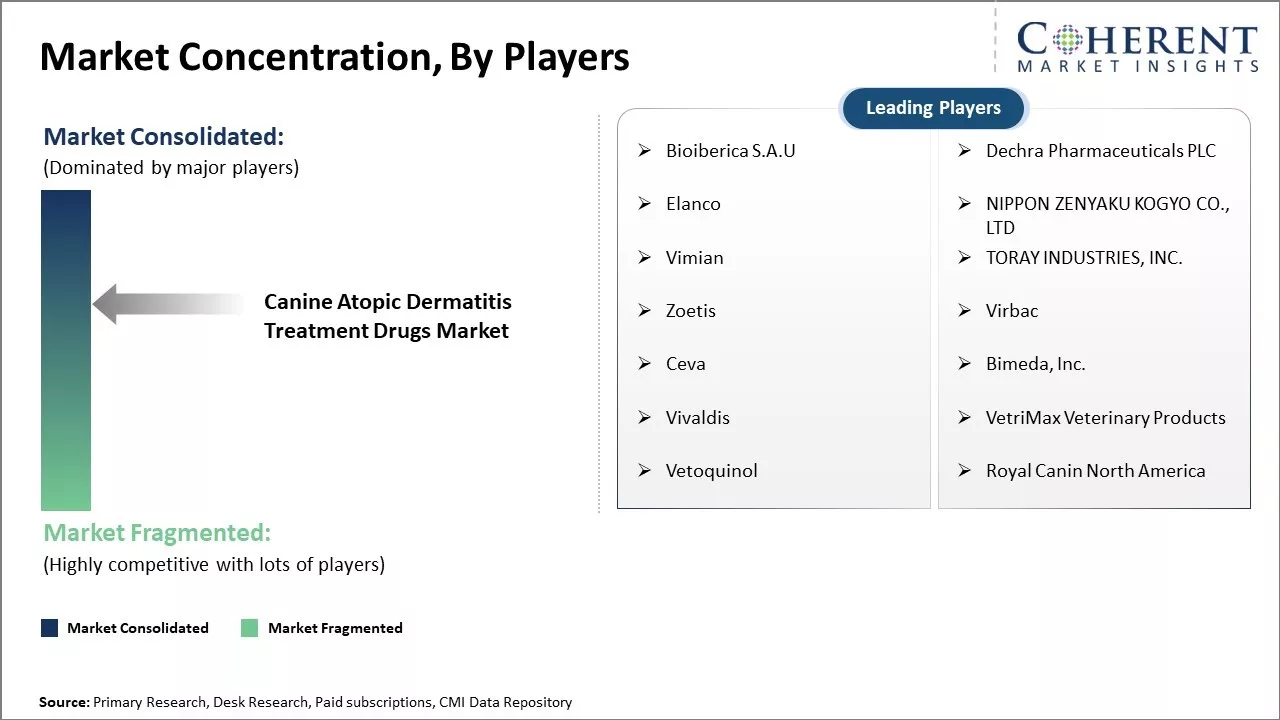
Get actionable strategies to beat competition: Download Free Sample
Increasing Prevalence of Canine Atopic DermatitisCanine atopic dermatitis (AD) is a complex disease with multiple contributing factors. It is characterized as an inflammatory and pruritic allergic skin condition that often occurs in dogs with a genetic predisposition and is associated with the production of immunoglobulin E (IgE) in response to environmental allergens. The most common and clinically significant feature of CAD is moderate to severe pruritus, which is accompanied by, and typically precedes, erythema, erythematous macular and/or popular eruptions, self-induced alopecia, excoriations, hyperpigmentation, and lichenification. According to the American College of Veterinary Dermatology (ACVD), the estimated prevalence of AD in dogs is approximately 10-15%. Furthermore, as per the data published in Blackmores, a leading natural health company, in September 2020, atopic dermatitis is the second most prevalent allergic skin disease in dogs. Golden Retriever, German Shepherd, Labrador, and Pug breeds have been proven to be the most prone to canine atopic dermatitis. Canine AD is a chronic condition that significantly affects a dog's quality of life. Itchy and inflamed skin can cause discomfort, pain, and distress for affected dogs. As pet owners prioritize their pets' well-being and seek to improve their quality of life, they are more inclined to explore and invest in effective treatments. Thus, emphasis on improving the quality of life for dogs with AD drives the market growth.
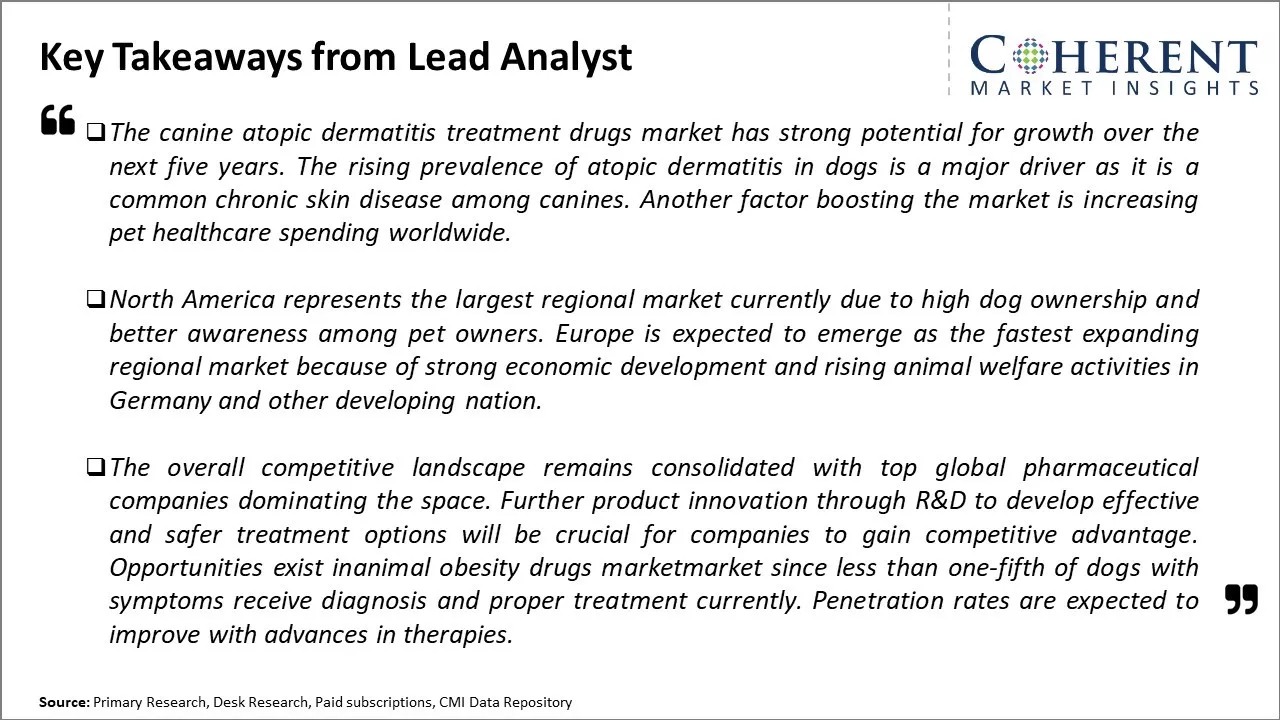
To learn more about this report, Download Free Sample
Market Challenges – High Cost Associated with Canine Atopic Dermatitis Treatment DrugsThe canine atopic dermatitis treatment drugs market is facing challenges due high cost associated with canine atopic dermatitis treatment drugs. Many of the medications used to treat canine AD, such as Apoquel or cyclosporine, can be expensive. These medications may need to be administered over an extended period, adding to the overall treatment cost. The high cost of medications can deter some pet owners from seeking proper treatment or limit their ability to afford long-term management, thus impacting the market growth. For instance, Cytopoint injection for dogs’ costs around US$ 50-US$ 200 per injection. This can translate to a cost of between US$ 300 and US$ 800 for a four to six-month supply. The high costs associated with canine AD treatment may lead to disparities in accessibility, with some pet owners unable to afford or access necessary treatments. Moreover, the most expensive medicines for canine atopic dermatitis are Atopica/Cyclavance/Sporimmune. A month’s course of these capsules for a medium sized dog costs around US$ 345.
Market Opportunities – Emerging Stem Cell Therapies for Canine Atopic Dermatitis
There is a strong demand for the development of new regenerative treatments for canine atopic dermatitis, which presents potential for pharmaceutical and biotechnological companies to provide new medications for the condition. Due of their immunomodulatory capabilities, mesenchymal stem cells (MSCs) are a special kind of cell that can heal tissue and organ damage brought on by autoimmune diseases or chronic inflammation. Stem cells have the ability to differentiate into different cell types and promote tissue repair and regeneration. In the context of atopic dermatitis, stem cells could potentially help regenerate damaged skin tissues and promote healing. This could lead to improved skin barrier function and reduced susceptibility to secondary infections. Additionally, stem cells can be administered locally, either through injections or topical application, directly to the affected skin areas. This localized delivery allows for targeted therapy and minimizes systemic side effects.
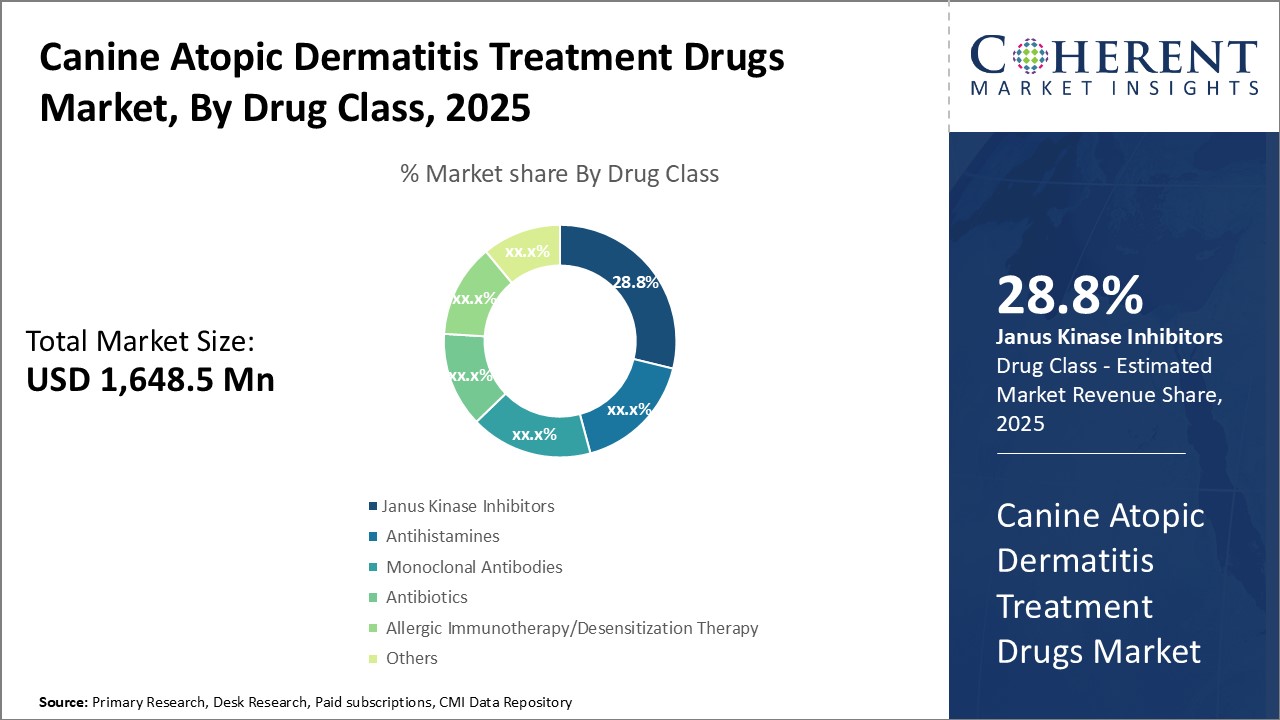
Discover high revenue pocket segments and roadmap to it: Download Free Sample
Insights, By Drug Class: Better Survival Rates and Rising Approval by Regulatory AuthoritiesThe drug class segment includes Janus kinase inhibitors, antihistamines, monoclonal antibodies, antibiotics, allergic immunotherapy/desensitization therapy, and others. The Janus kinase inhibitors subsegment is expected to hold 28.8% of the market share in 2025. Majority of market players are focused on manufacturing medicines based on demand which can drive the segment growth in the market. APOQUEL (oclacitinib tablet) manufactured by a major player, Zoetis Inc. (veterinary pharmaceutical company) is a Janus kinase inhibitor, which is the most extensively used treatment for canine atopic dermatitis. The Janus kinase inhibitors segment is expected to show significant growth over the forecast period, owing to its better survival rates and rising approval by regulatory authorities. For instance, on January 10, 2022, Zoetis, a global animal health company, announced that the European Commission (EC) had granted the marketing authorization for Apoquel chewable tablets (oclacitinib). It is a novel Janus kinase inhibitor indicated for allergic dermatitis in dogs.
Insights, By Route of Administration: Higher Absorption and Onset of Action
The route of administration segment includes injectable, oral, and topical. The injectable subsegment is expected to hold 34.7% of the market share in 2025 owing to its higher absorption and quicker onset of action compared to other routes. Injectable drugs bypass hepatic first-pass metabolism and reach therapeutic concentrations in the bloodstream at a faster rate. They also ensure 100% bioavailability and compliance since the medication is administered by a veterinarian. This is highly important for effective management of severe flares and acute exacerbations of canine atopic dermatitis which require rapid relief from pruritus and inflammation. Injectable drugs particularly suit hospitalized and critically-ill dogs where oral administration may not be feasible. Further, self-injectable formulations enhance owners' convenience and compliance to the prescribed treatment protocols.
Insights, Distribution Channel: Easier Accessibility and Wide Range of Options
The end user segment includes online and offline. The offline subsegment is expected to hold 68.8% of the market share in 2025 owing to its advantages of easier accessibility and wide range options. Online pharmacies allow pet owners to purchase prescription and over the counter medications from the comfort of their homes at competitive prices. This channel has gained prominence during the pandemic as people avoided visiting clinics and hospitals. The online space also offers a diverse portfolio of national and private label brands along with value packs and subscription services. Product reviews and virtual consultations further aid selection. Information is easily available online to address owner queries. Additionally, online stores ensure seamless delivery even in remote locations. Convenience aspects like these will continue driving the online segment's growth in the canine atopic dermatitis treatment drugs market.
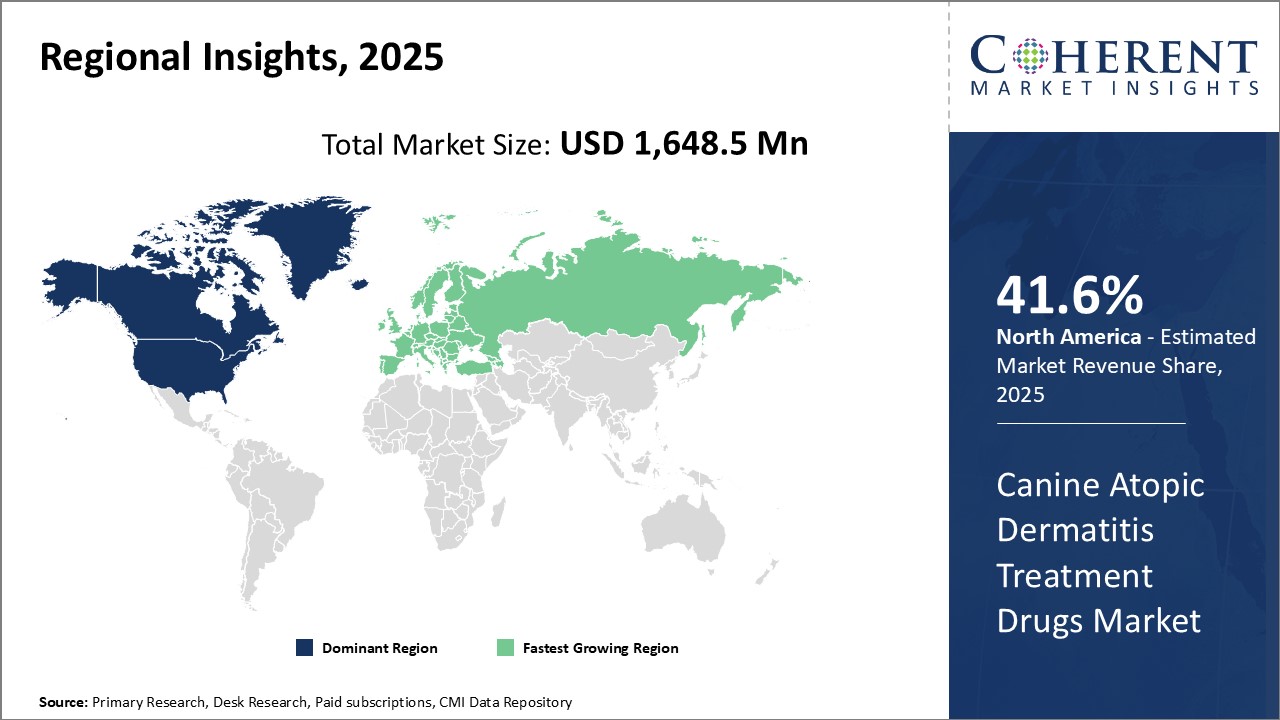
Need a Different Region or Segment? Download Free Sample
North America remains the dominant region in the global canine atopic dermatitis treatment drugs market and is anticipated to hold 41.6% of the market share in 2025 owing to a strong presence of leading manufacturers in the region. The U.S. accounts for the largest share primarily due to high pet adoption and high expenditure on pet healthcare. Pet owners in the U.S. are increasingly willing to spend on premium drugs for atopic dermatitis treatment of their dogs. Further, awareness regarding atopic dermatitis is also higher among pet owners in the country driving the sales of prescription drugs. Leading pharmaceutical companies such as Zoetis, Elanco, and Virbac have established their bases in the U.S. to cater to the growing demand. The Europe canine atopic dermatitis treatment drugs market is currently the fastest growing regional market globally. Germany holds the largest share within Europe owing to high number of companion animal practices and increasing pet healthcare expenditure. Countries including France, Italy, and the U.K. are also lucrative markets contributing to Europe's overall growth. Higher pricing of drugs is supporting the market growth in monetary terms. Growing number of atopic dermatitis cases in dogs is facilitating the demand for effective treatment options. In addition, supportive regulatory environment and rapid product approvals provide impetus to local pharmaceutical players to launch innovative therapies in the region.
Canine Atopic Dermatitis Treatment Drugs Market Report Coverage
| Report Coverage | Details | ||
|---|---|---|---|
| Base Year: | 2024 | Market Size in 2025: | USD 1,648.5 Mn |
| Historical Data for: | 2020 To 2024 | Forecast Period: | 2025 To 2032 |
| Forecast Period 2025 to 2032 CAGR: | 10.3% | 2032 Value Projection: | USD 3,276.3 Mn |
| Geographies covered: |
|
||
| Segments covered: |
|
||
| Companies covered: |
Bioiberica S.A.U, Dechra Pharmaceuticals PLC, Elanco, NIPPON ZENYAKU KOGYO CO., LTD, Vimian, TORAY INDUSTRIES, INC., Zoetis, Virbac, Ceva, Bimeda, Inc., Vivaldis, VetriMax Veterinary Products, Vetoquinol, and Royal Canin North America |
||
| Growth Drivers: |
|
||
| Restraints & Challenges: |
|
||
Uncover macros and micros vetted on 75+ parameters: Get instant access to report
*Definition: The canine atopic dermatitis treatment drugs market consists of pharmaceutical products used to manage the symptoms of atopic dermatitis in dogs. Atopic dermatitis, also known as atopic eczema, is a common allergic skin disease in dogs where the skin develops an inflammatory response to allergens such as pollen, dust mites, and certain foods.
Share
Share
About Author
Ghanshyam Shrivastava - With over 20 years of experience in the management consulting and research, Ghanshyam Shrivastava serves as a Principal Consultant, bringing extensive expertise in biologics and biosimilars. His primary expertise lies in areas such as market entry and expansion strategy, competitive intelligence, and strategic transformation across diversified portfolio of various drugs used for different therapeutic category and APIs. He excels at identifying key challenges faced by clients and providing robust solutions to enhance their strategic decision-making capabilities. His comprehensive understanding of the market ensures valuable contributions to research reports and business decisions.
Ghanshyam is a sought-after speaker at industry conferences and contributes to various publications on pharma industry.
Missing comfort of reading report in your local language? Find your preferred language :
Transform your Strategy with Exclusive Trending Reports :
Frequently Asked Questions
Joining thousands of companies around the world committed to making the Excellent Business Solutions.
View All Our Clients